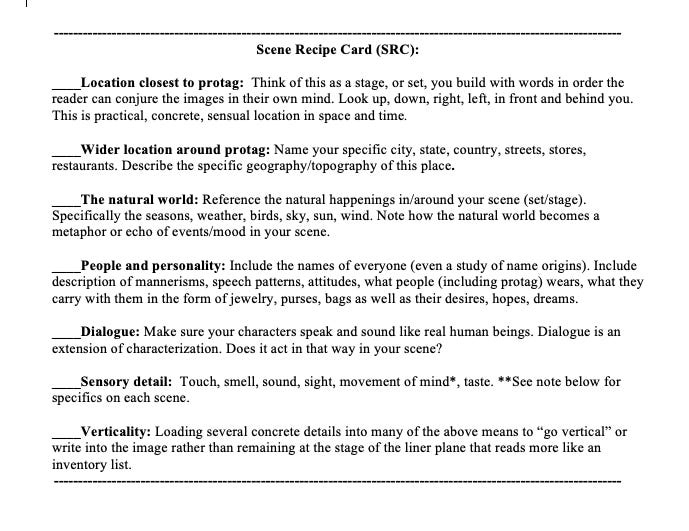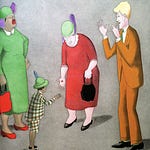Learn the essential building block of great memoir, featuring a practical tool that transforms good writing into unforgettable storytelling. Plus, discover why mastering scene is the key to moving from reporting to art.
Welcome into Flight School:
Generally speaking scene is the building block of creative nonfiction...the widespread notion that nonfiction is the writer's thoughts presented in an expository or summarizing way has done little but produce quantities of unreadable nonfiction.
~ Brenda Miller and Suzanna Paola, Tell it Slant
Think of scene as a perfect pearl. Each one complete, beautiful, singular. As you write, you're stringing these pearls together to create something whole. A narrative essay might need five to fifteen pearls; a full-length memoir could require three hundred. But each pearl must be crafted with care.
The Anatomy of Scene
At its simplest, a scene is a moment in time where something happens to move the story forward. Note the singulars: "a moment," "something." Many writers, rich with thoughts and memories, try to pour everything onto the page at once. But great scenes require containment - one moment, one action, brought fully to life.
The Scene Recipe Card
To help writers master scene, I created a simple tool that breaks down the essential elements:
Location (immediate surroundings)
Wider Location (neighborhood, city, world)
Natural World (weather, seasons, environment)
People & Personality
Dialogue
Sensory Detail
Verticality
You can do this right now as you read this post.
🛑 STOP and look up. What’s over your head? Sky? Ceiling? Write it down.
Look down. What’s under your feet? A hardwood floor, or sand, or grass, or a carpet? Describe it.
What’s off to your right...
🗣 "Oh my Gosh, that’s so boring,” your head will insist. “Give me something more interesting to do.”
Okay…this interruption to the lesson is expected, so please go to the line on the SRC that reads sensory detail and continue through to “movement of mind.” Note the asterisk which I’ll add here: Movement of mind describes thoughts: associations, future, past, memory. Mind, or ordinary mind, is considered a “sense.” Not the driver!
Let’s get back to work.
We were looking right and describing what was there in your imagination or in your memory.
Then left.
Then forward.
Then behind.
Location is that simple. Slow down. Follow the recipe. Start describing.
Carrying on with the SRC to wider location, look out the window and describe your particular neighborhood with it’s particular streets, and street names, and land marks. You are also in a particular city, in particular state.
Time for the natural world now. What’s happening outside? Does the wind blow? The rain fall? Or has the sun just burned through the clouds? Are the birds are busy gathering twigs? Does one perch on your porch (say a Black Phoebe) and tweet tseep while cocking its head to one side?
Now lets look at people and personality. Perhaps you have a daughter just home from school who wears something very particular, her hair arranged just so, and her bag over her shoulder. She smells a certain way. Smiles a certain way. Hugs you in a certain way (or not).
Capture what she says (dialogue) and see how her words reveal her character, “What’s for dinner?” Or “Are we out of cookies?” Or, “Can I borrow the car?” Or “Why are you staring at me like that???”
All this is dialogue. Welcome to the party.
Then comes sensory details which I’ve already alluded to with the arrival of the daughter in our scene. She smells a certain way. She touches in a certain way. The feel of her hand on yours is very particular, and if you take a moment to consider how that touch feels and write it down, you are now in the realm of the sensory in your scene. And you are bringing that scene to life for the reader by including that sensation.
Verticality is about multiple concrete and specific details.
For example: She held a cup.
What kind of cup? What is the shape? Color? Is there something particular about that cup, something memorable or meaningful?
With verticality, you keep going vertical (rather than horizontal along the expository line of your story) until you arrive at the deeper meaning of the thing.
For example: She held a greenish blue cup that, if you looked closely, seemed cracked a thousand times over as if the potter who made it had no idea what they were about. It was actually not a flaw but an intention of the design. The cracks within the cup, when she looked at them, formed a spiral from the bottom to the rim and when drinking her tea, she studied the spiral for a long time and often felt she was dropping into it or perhaps emerging from the center.
Scene writing is basically attuning yourself to life itself. We are all living in scenes in every moment of our life. When you write a scene, your bringing yourself present to what is. And when you can learn to write this way, you are on your way to imparting this gift, first to yourself, and then to anyone who is lucky enough to read your work.
✍️Your Turn
Choose one moment you want to bring to life. Using the Scene Recipe Card, write down:
What's immediately around you
The wider world of this moment
The natural elements at play
Remember: You're not reporting - you're creating a moment readers can step inside and live.
~ Jennifer, 🐦⬛

















Share this post